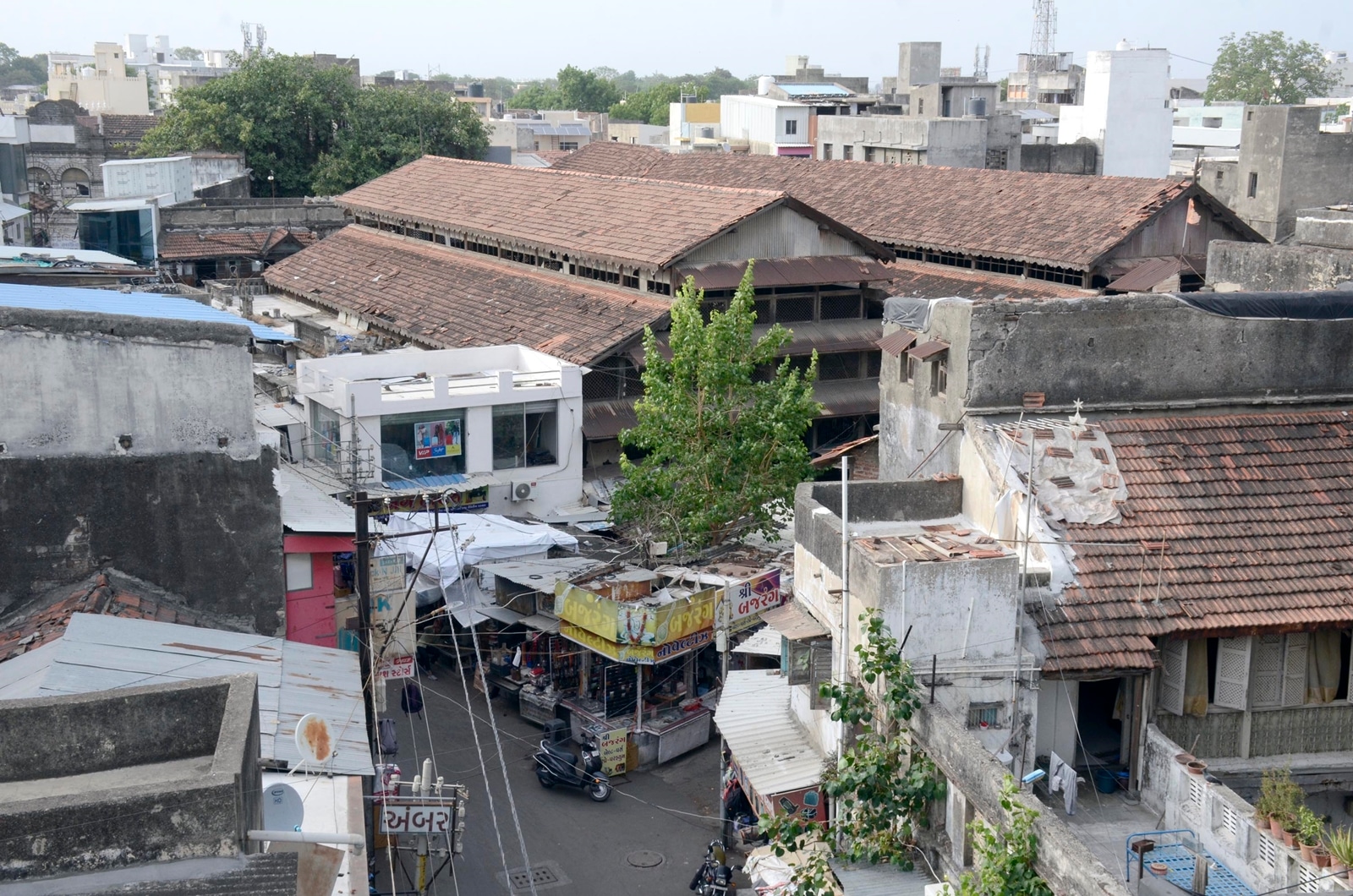Know Your City: Rajkot’s first vegetable market grows old but its grandeur endures
Sir Lakhajiraj Vegetable Market was established in 1934. The restrictions on autorickshaw entry a few years ago diverted customers to the nearby Jubilee vegetable market.
 Bhimji Korat hands over vegetables to a customer. (Express photo)
Bhimji Korat hands over vegetables to a customer. (Express photo)Rajkot, known as the city where Mahatma Gandhi spent his formative years, was featured in the 1981 Gujarati movie Pankhino Malo (bird’s nest). In the movie, actors Asrani and Jayshree T danced in front of major landmarks in the city to the tune of a Mahendra Kapoor song. One of the landmarks featured in the song is Dharmendra Road, which is mainly a clothes market. The song celebrates Rajkot as a colourful city blessed by God.
But at the junction of Dharmendra Road and Para Bazaar stands another landmark — Sir Lakhajiraj Shaak Market (Sir Lakhajiraj Vegetable Market), the first formal vegetable market of the city, which is popularly called the capital of the Saurashtra region of Gujarat. Anyone going towards Para Bazaar from the narrow and busy Dharmendra Road cannot help but get distracted by the high, Mangalore-tiled pitched roof of the vegetable market rising proudly over the surrounding buildings with fire-sheet roofs or modern flat roofs.
 “This was the first modern building constructed just outside the walled city in Rajkot as is indicated by the extensive use of steel,” says Prof Gaurav Vadher, an assistant professor at the city-based Indubhai Parekh School of Architecture. (Express photo)
“This was the first modern building constructed just outside the walled city in Rajkot as is indicated by the extensive use of steel,” says Prof Gaurav Vadher, an assistant professor at the city-based Indubhai Parekh School of Architecture. (Express photo)
The market’s four open gables, with finials tipping the ridge boards of the M-shaped roof, stand out from the immediate surroundings and impart the structure the architectural grandeur of a bygone era. As one enters the market, what catches the eyes is the 40-foot high roof, supported by scissor trusses having a horizonal tie member each and wooden ridge board and rafters.
The trusses rest on 48 steel stanchions, 24 wooden columns and limestone-block walls. From the four entrances are visible the two planes in the roof—the upper plane’s eaves extending over the stanchions and the lower plane’s rafters starting from the beams resting on stanchions and leaning to the sidewalls of the structure.
 Prakash Meghani says he has started making home delivery of vegetables. (Express photo)
Prakash Meghani says he has started making home delivery of vegetables. (Express photo)
Though the entire structure is seemingly seamless, vendors say the smaller section with its gate opening on Dharmendra Road is an extension. The plate on that gate reads ‘Sir Lakhajiraj Vegetable Market, Year of Establishment: 1934’ and has as a relief the royal insignia of the erstwhile princely state of Rajkot. The so-called old market has 16 large platforms for vending vegetables. The so-called new one is smaller, having only eight vending platforms.
“The indicators of the era in which the main market was built lies in the roof,” says Premji Sakariya, president of Sir Lakhajiraj Vegetable Market Retail Merchants Association, while pointing to four pulleys suspended from the roof. “Lanterns were lit and then hoisted up by a rope round the pulley,” he says, adding, “Rajkot was electrified in 1930, and therefore, the new market lacks the pulleys.”
The interior of the building is literally cast in stone. Cobbled-stone flooring looks new more than a century later. The vending platforms are also constructed using basalt, but the stones seem to have been sized with perfect angles.
 Sir Lakhajiraj Vegetable Market in Rajkot. (Express photo)
Sir Lakhajiraj Vegetable Market in Rajkot. (Express photo)
“This was the first modern building constructed just outside the walled city in Rajkot as is indicated by the extensive use of steel,” says Prof Gaurav Vadher, an assistant professor at the city-based Indubhai Parekh School of Architecture. “The structure has an attractive pitched roof. Because it is a public building, it required volumes to make it look grand. The architects played with the volume by dividing the roof into two planes and thereby breaking the linearity of the roof and also leaving space for ventilation and letting in sunlight while also distributing the weight of the structure,” adds Vadher.
 Premji Sakariya says the building needs repair urgently.(Express photo)
Premji Sakariya says the building needs repair urgently.(Express photo)
The professor says the building is simple yet unique. “It is a simple building with a roof with imprints of British architecture. But its beauty lies in its orientation, its spatial articulation of the trussed roof on a curving plan and its climatic response,” Vadher elaborates.
However, the market now seems well past its glory days. It has very few vegetable vendors and fewer buyers, a complete misfit in one of the most crowded shopping districts of Rajkot. It looks more like a milestone in time than a place in sync with the high-paced modern city life. Out of the 144 platforms created by dividing the 24 large platforms, only around 35 are now actually selling vegetables and fruits.
“Mostly women and elderly are the ones who come to purchase vegetables. Around eight years ago, entry of autorickshaws on Parabazaar and Dharmendra Road was prohibited. Women and the elderly can’t lift weights and walk half a kilometre to catch an auto from Jubilee Chowk. The restrictions on autorickshaw entry diverted customers to the nearby Jubilee vegetable market and made Sir Lakhajiraj Vegetable Market dispensable,” says Sakariya.
“It is only the old loyal customers who take the pains to come to us for their need of vegetables,” says Bhimji Korat, 64, a vegetable vendor whose father Arjanbhai was the one who was allotted a platform around 75 years ago in this almost-a-century old market.
 Dahya Meghani in his fruit shops at the entrance of Sir Lakhajiraj Vegetable Market. (Express photo)
Dahya Meghani in his fruit shops at the entrance of Sir Lakhajiraj Vegetable Market. (Express photo)
Not only has the vegetable market suffered in sales volumes, but the building has also been worn down. “It takes at least four men to open the iron chain-linked roller shutter in the market’s gate opening on Dharmendra Road. The roof is all leaky during monsoon,” complains Prakash Meghani, a vegetable vendor in the extended part of the building.
The market is now the property of Rajkot Municipal Corporation (RMC), and the civic body charges vendors Rs 590 rent per month. Dipen Dodiya, RMC’s in-charge city engineer, says, “It’s an old structure, and we will undertake repair and renovation if necessary.”
But Dahya Meghani, 72, a third-generation fruits and vegetable vendor after his father Keshubhai and grandfather Kachrabhai, sounds resigned to this market. “Our market started losing business after Jubilee Vegetable Market was inaugurated in 1975. The ban on autorickshaws proved the proverbial last nail. We have seen days when people used to hire labourers to carry their vegetables from a platform in this market to autorickshaws waiting on the road. But it seems, like us vendors, this market has also grown old now,” says the septuagenarian.












